Private Pier — Fishing License Required
Every pier has its story and one of the most interesting here took place during a visit in 1997. I had arrived late in the afternoon, checked into the motel, and headed straight over to the dock for some fishing. But, I wasn’t having much luck (in fact no luck) until I struck up a conversation with a couple of the local youth who were waiting for their father to finish unloading his commercial fishing boat. Did they fish off the wharf? “Sure,” they replied. Where did they catch most of their fish? “Inshore near the rocks.” In response, I moved to the specific piling that they said was “the spot.” And sure enough, I started to catch fish. First fish to greet Mr. Jones was a kelp greenling (sea trout) followed by a small black rockfish and then a copper rockfish.
About then the two boys asked what I was using for bait and I replied that I had some frozen tube worms that I had bought in Eureka. How much had I paid for them? “About three dollars for a one-ounce cup” was my reply. Would I like a couple of batches of the worms? “Sure,” I said, “but where do you get them?” Turns out the tires that line the pilings to protect the boats are chock full of tube worm colonies. In fact, basically every tire had a mass of the interesting worms and their tube-shaped homes. The helpful duo brought me two of the strange looking masses and then showed me how to squeeze out the tube worms (it’s sort of like squeezing tooth paste out of a tube). Figure out where the dark head is located and squeeze from that point. Soon the 4-12 inch worms pop out from the other end of the tube. Truly interesting and later, when I had time to squeeze out all the worms, I came out with what I guess was at least $20-$30 worth of the worms. I always say learn from the regulars (the locals) and this fortuitous meeting proved the maxim true once again.
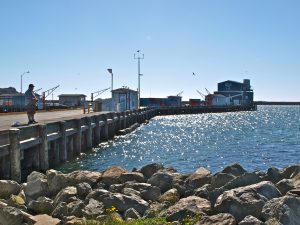
But that’s only part of the story. I noticed while fishing the selected piling that there was a large rock near the shoreline with a hole in it; a round shaped hole 8-10 inches in diameter. Might there be a fish in the hole, perhaps a monkeyface (eel) prickleback, a wolf eel, or an octopus? There was only one way to see, so I carefully dropped my line straight down into the hole. Nothing happened for a second and then I had a terrific hit. But, unfortunately, whatever had grabbed my bait didn’t let go and I lost my sinker and hook. Soon I had a new sinker, a sharp new hook, and a new piece of bait ready to go. Back into the hole went my line. This time there was an almost instantaneous hit and I gave a quick jerk. I thought I had lost my line again but instead a cabezon came shooting out of the hole, fins bristling and mouth gasping—but he was mine, and I soon had the medium-sized cabezon up on the dock. However, I release most of the fish I catch and he was no exception. I dropped him back into the water and watched him speed toward his personal penetralia, the small hole which apparently served as home. I didn’t have the heart to drop the line in there again—at least not on that visit.
After that day my first stop at the pier would always be those inshore rocks and several times, depending upon the action, I never ventured further out on the pier. Today you don’t have much choice since a few years ago the city decided to prohibit fishing from further out on the dock (resulting in today’s designation as a private pier requiring a license). The change, unfortunate in my opinion, is due, I imagine, because authorities didn’t want anglers interfering with the commercial operations on the dock. Luckily the rocky inshore area is still available along with the inner wall of the harbor.
Nine different species of rockfish, seven different species of sculpin (including cabezon and irishlord), lingcod, several different pelagic species (including Pacific herring, Pacific sardine, Pacific mackerel and northern anchovy), and a plethora of other species, 27 in all, have made Citizens Dock the pier with the highest average number of fish per hour (11.4) of all the various north coast piers that I have fished. And, that rocky inshore section has provided most of the fish
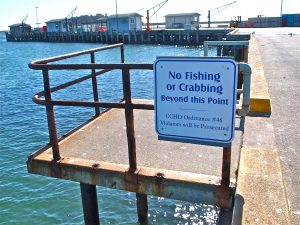
Environment. Citizen’s Dock is 900 feet long, has a somewhat L-shaped end, and sits near the eastern corner of Crescent Harbor. The water around the dock is fairly deep and usually calm while the bottom is primarily sand and mud. The pilings, though numerous, have little growth of fish attracting mussels although they are covered with barnacles.
The entire area has a “fishy” feel to it and the dock itself would seem to be a perfect spot for fish. Nevertheless, while the dock proved to be a good base from which to catch the transient schooling species, it rarely was as productive for the resident bottom species. The exception was the inshore rocky area, a 20-foot section that in reality represents less than one percent of the dock’s railing space.
But why doesn’t the piling environment itself attract the same bottom fish, the rockfish, cabezon, greenling, and perch? The answer is pretty clear when you look around the harbor. Rocky shore species of fish tend to be found around rocks and jetties. Here, just east of the pier sits the rocky breakwater that runs from Whaler Island to the sandy shoreline. South of the pier, connecting to the other end of Whaler Island is the Inner Jetty. The J-shaped structure made up of the jetty, island, and breakwater, provide protection for the pier as well as assuring a safe haven for boats. At least most of the time! In addition to protection, the rocky structures provide a more favored environment for the rocky species.
Talk to any of the locals and they will say that if you’re seeking out perch, rockfish, and greenlings, try the jetties. When piers are built over sandy bottoms the piers normally act as fish attractants, much like artificial reefs. But here there is abundant shelter and more natural attraction at those nearby rocky areas. Nevertheless, I have caught a variety of the rocky species from the outer portions of the wharf—just not to the same extent as the inshore rocks.
However, given that people are no longer able to fish from Citizen’s Dock it’s somewhat irrelevant how fishing was on the main part of the dock.
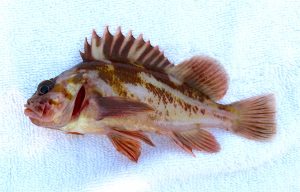
Numerically the main species encountered in the harbor area by the dock are the smaller schooling species. A number of pelagic species enter the harbor of which herring are the most numerous and most favored by anglers. Late winter to spring, the end of January through February, will usually see large schools of herring entering the bay to lay their eggs. When the herring run is good, the harbor will not only be clogged with the shiny fish but also large numbers of northern California and southern Oregon anglers. The anglers, often decked out in coats and raingear to fight the rain and wind, will literally fill coolers with the small fish, some to be eaten and many to be saved and used as salmon bait later in the year.
In the spring, redtail and calico surfperch may enter the harbor and both winter and spring will offer up starry flounder. In the summer to fall months, schools of walleye and silver surfperch, white seaperch, shinerperch, jacksmelt, true smelt (surf smelt), anchovies and sardines may settle in around the dock. Late spring to fall will see some black, blue, brown, and copper rockfish down around the pilings, while black-and-yellow rockfish, supposedly only found north to Eureka, have been reported from the adjacent jetty by the PFIC’s Songslinger (and he’s very knowledgable as far as fish). Summers can see the waters around the dock saturated with a variety of juvenile rockfish and lingcod.
Year round, an angler may encounter a resident kelp greenling, rock greenling, cabezon, striped seaperch, or any of several types of sculpin but, as mentioned, the inshore rocks are the best area for these species. At times dogfish sharks, leopard sharks, skates and bat rays are caught, but since most of these hit better at night, and since the dock is closed at night, the numbers are small. Most years will also see a few halibut, salmon, and lingcod landed, but generally it’s only a few (although some years have seen fairly big numbers of salmon).
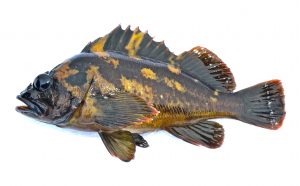
Fishing Tips. You’re presented two environments to fish. The first is the deeper water areas out in the harbor (available with a good cast from the shoreline area). Here you can fish for the resident bottom fish, and a simple high/low rigging utilizing shrimp, tube worms, or fresh mussels will be most productive. Keep the gear light; use a small hook, size 4-6, and fish under the pier, as close to the pilings, as possible. Most commonly you will catch sea trout (kelp greenling), cabezon or small rockfish. Striped perch are your best bet for large perch although redtail surfperch and a few pileperch will also enter into the mix; striped and redtails are most common in the spring while piles, white seaperch, and shinerperch can be taken most of the year.
When schools of smelt, sardines, herring or anchovies show up, jigging with a size 10-12 Sabiki or Lucky Lura-type bait rig can produce fast results. Generally the best approach is to cast out and use a quick retrieve but different fish sometimes require a different retrieve so don’t be afraid to experiment. Put a shiny torpedo sinker on the end of your line or use a gold or silver spoon equipped with a hook; sometimes this will hook the fish. For herring especially, the late hours just before dark, and the top of high tide, should be most productive. For jacksmelt, a series of small hooks baited with pieces of worm, and fished under a bobber, tend to yield the best results.
The only problem with using bait rigs at the dock is the danger of hooking small, juvenile rockfish. Sometimes the waters around the dock seem saturated by these small fish, a plethora of hard-to-identify species, and it’s hard not to hook them if using Sabiki’s or similar bait rigs. Keeping your rig in motion near the top of the water, or mid-level, might be OK, but drop it down in the water and you will often come up with 4-6 of the tiny fish. To make it worse there are sometimes schools of ravenous, juvenile lingcod hanging just under the rockfish. They too will hit the bait rigs and sometimes you’ll wind up with several rockfish and a couple of lingcod on your bait rigs.
Given that several rockfish are now illegal to keep, and that the tiny lingcod are far under minimum size, they’re not a good catch. Since it can be almost impossible to keep them off your bait rig it’s sometimes best just to switch over to your bottom set up (although these small fish can grab a surprisingly large bait for their size). This situation primarily seems to be an aestival, June to September problem, when the juvenile fish enter the harbor for the summer months. The bad news is that you don’t want to hook the fish. The good news is that the hoards of small fish undoubtedly attract larger fish.
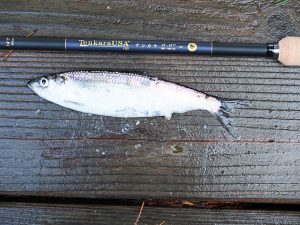
When (and if) the salmon show up near the dock, use a whole frozen anchovy or catch a small fish off of the dock (perch or smelt) for live bait. Fish the bait under a large float and keep it 3-4 feet under the top of the water. Since the dock surface is fairly close to the water, you may not even need a sinker. Try to position yourself so that the current is taking the rigging away from the pier.
A few legal lingcod will make an appearance and most are caught on swim baits fished with a leadhead jig. The same swim baits will occasionally also attract Pacific halibut (generally small ones) as well as California halibut. Neither fish is all that common from the dock but enough are caught to keep it interesting. Most of the halibut though are caught on bait—sardines, herring, or anchovies. When these baitfish show up in the harbor, use them as live bait, when absent use frozen bait. Although I’ve never seen them used as live bait here, shinerperch are often common inshore and also make good live bait for halibut. Sand soles and sanddabs are other commonly encountered flatfish but for both of these use small size 6-4 hooks and strip bait, worms or shrimp.
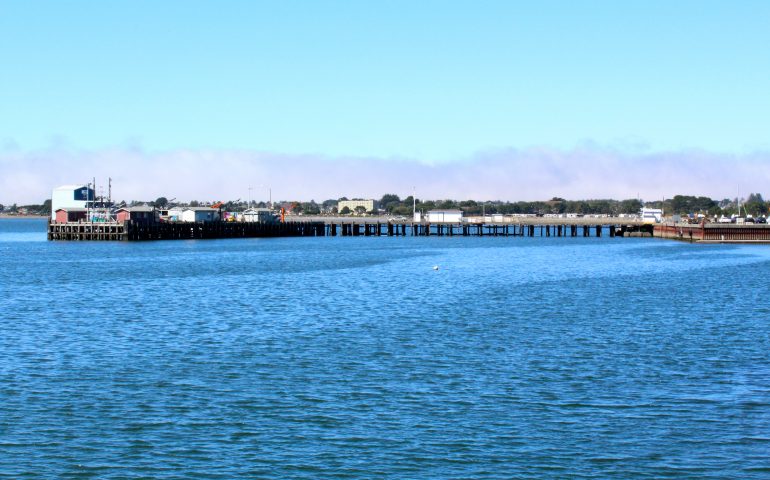
I am trying to find out how long can we crab from the pier—it usually goes to the end of July but I heard state shortened the season –does this include us dock crabbers